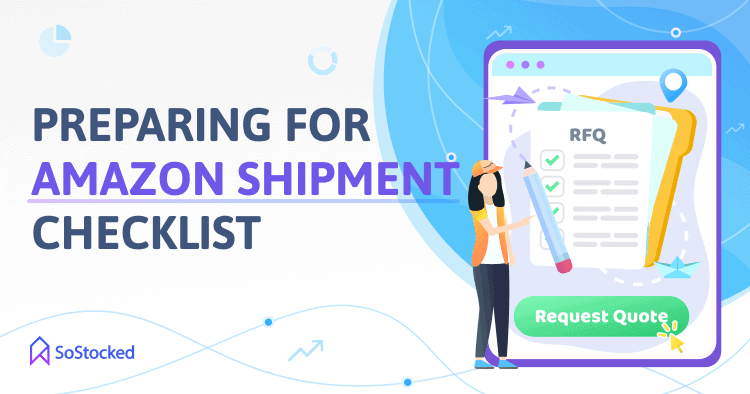
Preparing For Amazon Shipment Checklist (Includes Template)
…So You Don’t Miss the Boat!
Detail is at the center of every well-structured Request For Quote (RFQ) form. The more details you provide, the better, as it will improve the quality and accuracy of the cost estimates you receive and in turn, shorten your RFQ process by providing what is needed to your freight forwarder from the start.
But if you don’t know what details to include or use incorrect data, you’re likely to end up going back and forth for clarifications with your freight forwarders. Worse, it takes them days to get back to you because they’re busy people, too. The result? You miss the boat.
No seller wants to miss the boat and spend more money on expedited shipping (unless absolutely necessary).
So, what can you do to get shipping quotes faster without sacrificing the quality of responses?
This blog post will walk you through everything you need to know about Shipment Request for Quote (RFQ), including some pro tips and tricks that will help you speed up your shipping quote selection process.
Also included in this post is a downloadable Shipment RFQ Form that you can use to ensure you’re sending your freight forwarders all of the information needed to minimize delays due to back and forth clarifications. You don’t want your RFQ process to take weeks, as shipping quotes are only valid for a short period of time due to the fact that container rates fluctuate frequently like the stock market.
Pro tip: Freightos has a great resource for tracking these changes which could help you to better understand this part of your business and give you more prediction and understanding as to why your quotes may be higher or lower than expected.
In this Preparing For Amazon Shipment guide, we’ll take a look at:
What is a Shipment Request for Quotation (RFQ)?
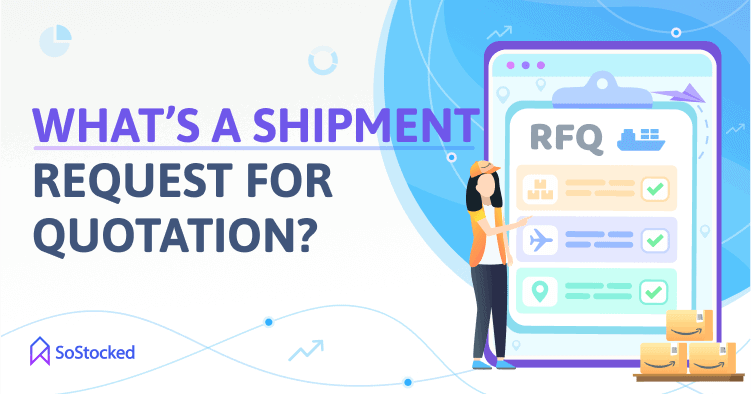
RFQ, also known as a freight quote, is a document used when inviting freight forwarders to send their quotes for consideration for a shipment. This document outlines the details about the logistics service needed by the shipper, and the freight forwarder will make a cost estimate based on that information.
A shipment RFQ form typically includes:
- Product details (Description of the product, product name, and product ID)
- Address information (both origin and destination)
- Shipping terms
- Mode of Transport
- Cargo Ready Date
- HTS Code
- Packaging details (carton dimensions, units per carton, weight, among others)
An RFQ form can either come as a part of a Request for Proposal (RFP) or be sent independently. You can use RFQs as a standalone form if you already know the specific requirements for handling and transporting your inventory from the point of origin to the final destination.
Is a Request for Quote (RFQ) the Same as a Request for Proposal (RFP)?
RFQ and RFP differ in terms of purpose. As mentioned earlier, you use RFQs to determine how much it costs to use a shipping company’s standardized logistics service—for instance, shipping a full container from China to the US or transporting a full truckload from your warehouse to Amazon FBA on a regular schedule. In other words, you already know what it is that you need from a freight forwarder and you’re just basically shopping around for the best shipping rates with the best lead times possible.
In contrast, RFPs are ideal for shippers looking for customized shipping solutions, where specific shipping needs for specific products are yet to be determined.
For example, you’re launching a new meltable product with time- and temperature-sensitive requirements like gummies and chocolates, but don’t know what container type to use and what shipping methods/routes offer the fastest way to get your goods on time. This is important because Amazon accepts meltable inventory from October 16 to April 14 only. Otherwise, it would be marked unfulfillable and thus, must be disposed of.
So, you create and send out an RFP to freight forwarders who can help you figure out the best way to ship your meltable inventory. Then, you may opt to attach an RFQ form (see my template below and tweak it based on your shipping needs) with your RFP to determine the cost to ship that inventory from source country to its final destination.
An RFP document typically includes:
- Introduction section or Company Overview. Is your business seasonal? Is it all year round? It’s important to share an overview of your business to help your freight forwarders know what to expect throughout the year.
- Scope and goals. Describe your specific shipping needs and requirements, including expected volume and frequency of shipping, origin and destination shipping locations, and any special requests. If they are not already familiar with FBA, you’ll also likely want to give your freight forwarders an idea about how Amazon FBA operates and stores products in their fulfillment centers. The more information you provide about your needs, the better, as it helps weed out FFs who may not be the right fit for your business.
- Non-Disclosure Agreement
- Shipping terms
- Special handling/stowing requirements. Does your cargo need refrigeration, hazmat protocols, or any other special handling requirements? What’s the ideal temperature range to set? Check with your supplier to ensure your product’s technical specifications are accurate.
- Payment terms
- Budget
- Submission deadline
Pro tip: It usually takes one to two hours to peruse a single proposal. So, it wouldn’t be wise to send your RFP document to more than 15 people. Otherwise, you risk becoming overwhelmed.
RFQ Preparation Checklist
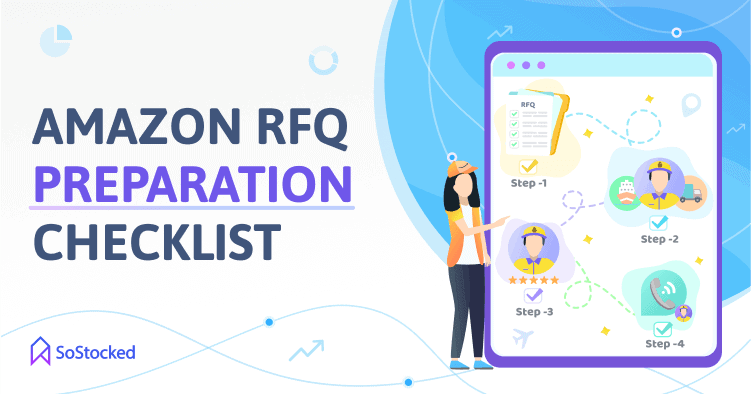
When you request a quote, your preferred freight forwarder will use the information you’ve provided to calculate the cost. One missing piece of information can keep a freight forwarding company from being able to execute a quote. This can become a real problem especially when you are dealing with China and the huge gap in time zones.
Many sellers arrange quotes by simply sending an email to their FF and asking them to send them a quote. But missing information means that, while you think you will wake up the next morning to a quote in your inbox, instead you have an email with a question. Delays such as this could mean you miss the deadline to get your shipment to the port and your inventory has to wait another week to ship out. This can, at times, be extremely detrimental to your business.
With something as important as this, it is actually surprising how few shipping companies have a ready-made form for you to fill out to make sure no information is left out. Fortunately, you’ll find an RFQ form template later on in this article. I personally developed a form based on my FFs internal checklist after experiencing such a delay.
First, let’s review what you need to make sure you have a well-defined and accurate RFQ document following the steps below.
Prepare the RFQ Document
While the preparation phase is often the most time-consuming, it’s also the most important. The first time you create your RFQ is usually the longest because you need to:
- Think about what precisely your shipping needs are
- Track down the data relevant to your shipping needs
- Organize and input that data into a spreadsheet
- Apply the right formulas to calculate packaging sizes, and weight, among other factors that are needed to determine your freight cost
Once you’ve gathered all of the necessary data, or know what details to include to receive accurate quotes, you’ll be able to create RFQs much faster for subsequent orders.
Pro tip: Make sure all of your data sets are 100% accurate by getting them from your supplier, supply management systems, and other legitimate sources. Because if you get it wrong, you could get a bad quote and commit yourself to something you don’t want or need. For instance, too much shipping space is expensive, and these days there may be a hefty cancelation fee (our FF charges $500 per shipment!) Or, not enough space, meaning you can’t send everything you need to send and you could stock out.
Vet Your Preferred Freight Forwarders
After creating your RFQ form, it’s time to round up all freight forwarders you want to get quotes from and start the initial vetting process.
Don’t spend more than one week vetting your freight forwarders. You want to get your goods shipped out as soon as possible as the industry is pretty volatile right now with the ongoing pandemic and incessant demand for sea freight from Asia to North America causing shortages, long wait times, and price hikes. So, expect sudden changes in sailing schedules. See my Transit Timetable below to work out a good timeline for your shipping process.
Below is my two-step vetting process. It should help you develop good criteria for selecting the best quote for your shipping needs.
1. Requesting for an initial quote from multiple FFs
What you want to do initially is decide what kind of shipping requirements you need. This way, you can set your focus right on freight forwarders that meet those requirements.
For instance, you only need someone who can offer affordable LTL shipping services with a CA to NY shipping route. So, that immediately eliminates trucking companies that don’t ship goods to those states mentioned.
The same thing goes for other shipping needs that require a specific mode of transportation, shipping lanes to certain marketplaces (EU, UK, or the US), and shipping service (standard or express). Talk to your supply chain manager and your freight forwarders regularly for the best and most current shipping advice. For ground shipping, be sure to consult with your warehouse manager.
Next, get information and quotes from multiple freight forwarders and then build a short list of 3 to 4 candidates who have good prices and reputation (licensed and well-recommended).
After that, you can use your list to get future quotes and then make the best decision as to which freight forwarder to use based on your criteria and individual shipping needs. Of course, you’d want someone with an offer that meets your budget, port requirements (proximity to your 3PL warehouse and the least backlogged), shipping method, and lead time.
It’s also best to choose freight forwarders whose services allow for flexibility of ports. This way, you will have a logistics partner who can ship to each port or area where you operate. This is especially helpful during times of port congestion. Your FF can quickly help you find an alternative port, modes of transport, or the best course of action to ensure your shipment still gets delivered on time.
By having a well-structured shipping RFQ template (scroll below to download ours) and list of preselected freight forwarding companies, you can quickly conduct your RFQ process whenever you need to.
2. Requesting a quote from your current short-listed FFs
There are many good reasons why you will want to work with a single or shortlist of freight forwarders exclusively. These include:
- Convenience
- A simplified freight quote process, which means you’ll get quotes faster
- Get high-quality quotes from freight forwarders you have already vetted and proven to be flexible
- Your rates and lead time may be more predictable when working with familiar FFs
- Increased flexibility and versatility in your operations. A freight forwarder who knows his business and has also gained a deep understanding of your shipping needs will know how to put your business in the best position when responding to sudden changes in the ports and shipping routes, helping you avoid costly delays.
After you have vetted your preferred FFs and sent your RFQ to them, expect a 24-hour turnaround time. However, if your RFQ has missing data or incorrect information, expect some delay, i.e., going back and forth for clarifications. Use my shipment RFQ template to avoid these problems.
Choose the Right Freight Forwarder
Selection is the second most critical phase in your RFQ process. During this stage, you decide who among your shortlisted FFs will execute your current shipment.
When reviewing the RFQs sent back to you, determine which freight forwarder meets all of your criteria.
- Which FF offers the most affordable rate?
- Which one is the most qualified to meet your unique shipping needs? Do they have the right vessel for your inventory? Can they meet your special handling requirements?
- Who has the best lead time?
- What are their ports and shipping methods? Do they offer ocean freight via some port in the country of destination, then railroad, and finally LTL? Or, ocean via what port, then ground only?
- What shipping lanes or maritime routes do they cover? This is important if you’re selling on multiple international marketplaces.
Your review process will be more straightforward if you utilize a standard RFQ template. It lets you ask all of your preferred freight forwarders for the same information, allowing you to maintain a level playing field.
It is not generally standard practice (and not necessary) to ask for detailed information on all shipping methods (i.e. ocean to train to ground to 3PL) and ports to be used. But being involved in this part of the process and understanding this part of your business empowers you to be more proactive in troubleshooting a lot of the chaos that we’ve seen across the supply chain and how you might navigate it more smoothly.
Once you’ve made a decision, keep a copy of the other quotes submitted by your preferred FFs, your evaluation criteria, and the selected freight forwarder for future use. Having clear documentation of the whole process offers transparency to everyone involved and helps you to polish your subsequent RFQs forms.
Close the Deal
Connect with your chosen freight forwarder to close the deal, i.e. locking in your commitment to the shipment or even contract signing if required. It’s also crucial to clarify the payment terms if this is your first time working with this FF. Is it prepaid, cash on delivery, or 30-day terms, for example? This way, you can plan ahead, do your cash flow projections, and secure sufficient funding for your incoming shipment, if needed.
Once you’ve finalized everything, notify the unsuccessful FFs, thank them for their participation, and add that although you will not work with them for this shipment, you would like to keep their information and RFQs for future use. Additionally, consider opening an account with them so that when future opportunities arise, you could easily reach out to them.
Related: Amazon Freight Forwarder Fees
Amazon Shipment RFQ Form Template
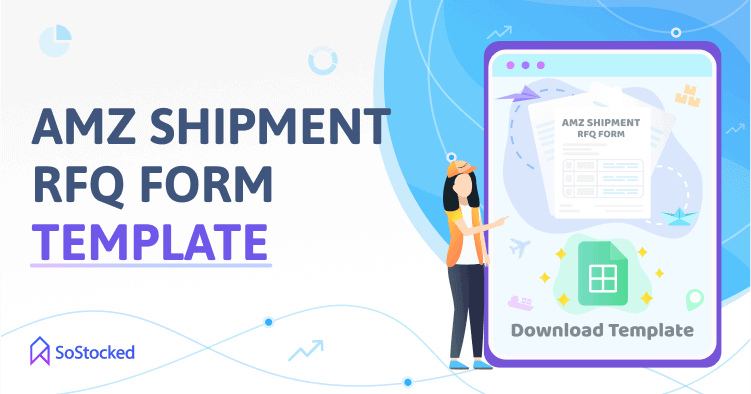
Download my Amazon Shipment Request For Quotation (RFQ) Template ➜
Improve your RFQ process by using this template!
It is designed to:
- Ensure no data is missing so your quotes are processed quickly, and as a result, you avoid missing the boat.
- Help freight forwarders understand your shipping needs in great detail.
- Make it easier for the FF’s project manager to share your quote request with other departments responsible for providing cost estimates.
- Providing you with all of the information you need to make an informed decision.
- Once filled out and sent back to you for review, the accomplished RFQ sheets allow you to compare offers easily and select the winner.
The template lets you provide your preferred FFs with the following information:
Origin Address
Input a detailed origin address (shipping point) with the postcode.
Destination Address and/or FBA Warehouse Code
Enter a detailed destination address with the postcode. If the cargo goes directly to Amazon FBA, please provide your warehouse code, e.g., ONT8. See the complete list of FBA codes here.
Destination Details
Provide the destination address and information about the location, such as if it is a warehouse, commercial, or residential address and if it is equipped with unloading docks, etc.
Shipping Terms
Describe the shipping terms between you and your supplier. Is it Free On Board (FOB) or Ex Works (EXW)? FOB means the supplier is responsible for the cost of loading the cargo on your preferred mode of transport at the shipping point. With Ex Works, it’s the other way around. The supplier isn’t responsible for the cost and responsibility of loading the cargo on your mode of transport at the port. Instead, they must ensure that the shipment is available at a designated location (e.g., factory), and your freight forwarder will then shoulder the transportation costs from the factory to the shipping point.
Cargo Ready Date
Enter the date your cargo will be available to ship.
Mode of Transport
Is it Express Air, Air, Express Ocean, Ocean, or Ground?
Product Details
This section describes what your product is. It has four columns, namely Product Name, Product Identifier, Product ID(s), and Description (material description, product category, and application). For the Product Identifier section, please provide a product page link or photo that carriers can use to double-check whether your cargo requires special handling.
Harmonized Tariff Schedule (HTS) or Harmonized System (HS) code
All import and export goods have an assigned HTS or HS code used for customs clearance purposes.
Packaging Details
Input your carton dimensions (L x W x H in cm), weight (kg), units per carton, and total units to calculate your Total Cartons, Total Weight, and Total Cubic Meters (CBM). This data will help carriers to calculate your quote.
With this shipment RFQ form, you’ll be able to provide correct information, speed up your selection process, and ensure you receive your goods on time.
Align RFQ to Shipping Timeline
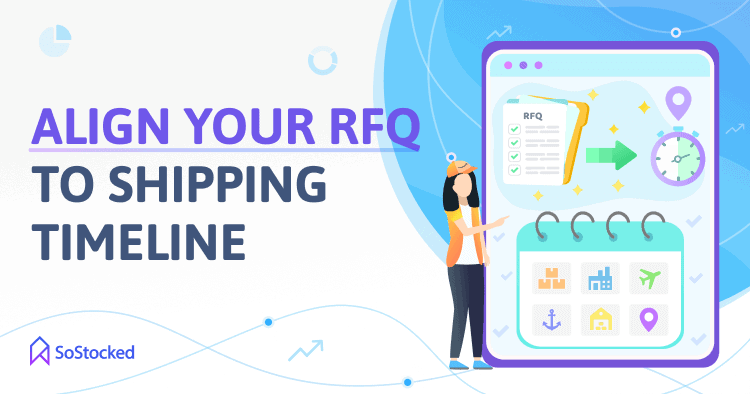
Keep your shipping process in mind while preparing your Shipment RFQ Template. You don’t want to send out RFQs too late, or else you’ll miss the boat or stock out before your inventory arrives. If you miss the boat, you’ll have to wait for the next available transport, which could take another week as shipments ship out weekly. It could even take longer if there is a cargo ship or container shortage and/or demand is higher than what the shipping supply offers.
Remember, freight forwarders typically need some time to work through your RFQ. I recommend closing the deal with your selected FF one to two weeks before the production of your goods is complete.
It’s also essential to ensure good coordination between your supplier and freight forwarder. For example, your FF must know your Cargo Ready Date and who will be responsible for loading your cargo on the vessel at the shipping point. This data comes from your supplier and if communicated to your FF properly, it will help prevent miscommunication between the two parties and shipping delays.
Additionally, your supplier should verify the carton weight, dimensions, units per carton and total cartons as well. I have personally experienced changing carton configurations only to have the supply, using old data, change it back, something which can become quite costly if not corrected on time.
Shipping Timeline
Familiarizing yourself with your freight forwarder’s shipping timeline will help you plan and execute your supply chain strategy better. Check with them regularly to see if the timeline/lead time has changed so you do not end up shipping out too late due to using outdated data.
Below is a breakdown of a typical shipping process.
However, it’s IMPORTANT to note that these dates will vary depending on the transit time estimates provided by your freight forwarder. While this is typical, in times of congestion such as Black Friday, holidays, or times when the supply chain is strained (such as the after-effects of post-COVID), you need to regularly check with your FFs to stay up to date on their schedule as shipping times will be longer.
| Stages of Shipping | Estimated Transit Time (Working Days) |
|---|---|
| Shipment set up | 2 to 3 |
| Pick up from factory and send to transit center | 1 to 2 |
| Arrived at transit center and customs exportation process | 3 to 5 |
| Released from customs and waiting to be loaded on a vessel | 1 to 5 |
| Onboard (Air) | 3 to 7 |
| Onboard (Ocean) | 30 to 35 |
| Arrived at the destination port and waiting to be discharged | 3 to 5 |
| Customs entry | 2 to 5 |
| Container discharged and picked up from dock, then sent to transit center for unloading | 3 to 5 |
| On delivery | 3 to 5 |
Currently, delays caused by the change in shipping lines, port congestion in the destination port, and lack of truckers are rampant. To get a more realistic timeline, allow an extra 7 to 15 days on your estimated transit time during times of added supply chain stress such as before sales holidays.
Related: Amazon Freight Forwarder Tips to Avoid Stockouts and Reduce Costs
Track Shipments with SoStocked
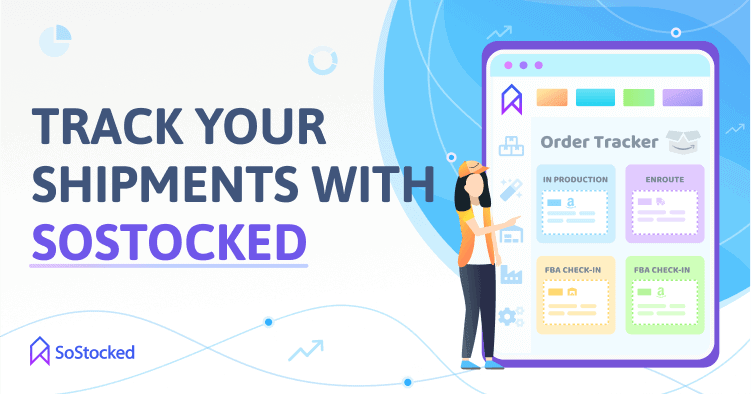
Getting a quote from your carrier is only half the battle; the other half is keeping an eye on your shipments to make sure they arrive at the final destination on time. In SoStocked, you can use:
Lead Time Management Tools
Assign a lead time to your Purchase Order (PO) or Work Order (WO) to track it within the software. For example, you can set an 80-day total production and shipping lead time for inventory orders coming from a shipping point in China to a port in the US via ocean freight. Using this lead time tracking, your Lead Time Flow would potentially look like this:
- In production: 30 days
- Ocean: 30 days
- Ground freight: 10 days
- FBA Check-in: 10 days
You can also create different lead times for different scenarios (e.g., air, ground, or a lead time that includes your 3PL warehouse instead of FBA). Click here to learn more.
Order Tracker
Once a lead time is assigned to a PO/WO, you can now track it using the Order Tracker. This dashboard tells you:
- What’s in production
- What’s en route
- What’s arriving at your prep center of 3PL warehouse
- What’s arriving at Amazon FBA
When you know the estimated arrival time of your POs/WOs, you can quickly identify which ones should have already arrived and which are scheduled to arrive at the final destination in the next few days or weeks in order to check with your warehouse, carrier or FBA shipment dashboard to see if the shipment has arrived or is on schedule or not.
Split a Shipment
Split a shipment within the same PO to be able to send inventory to two or more different locations or by multiple modes of shipping (air, sea, etc). You might want to split a shipment when your inventory level at FBA is running low, and you need to send in more stock from 3PL or factory by air express or small parcel delivery vs. LTL (less than truckload) to prevent a stockout. Instead of creating two separate POs or WOs, simply split the shipment within the same PO or WO. Then, send a portion of your cargo by one shipping method and the rest by another.
Inbound Shipment Dashboard
Inbound Shipment dashboard shows you what POs/WOs are arriving at FBA or your warehouse based on your lead times.
Inventory On-Hand Dashboard
This dashboard provides up-to-date information on all your incoming inventory and available units at 3PL warehouses and Amazon FBA, including those in reserved status.
Blackout Dates Calendar
Anticipate and plan for factory closures and national holidays using our Blackout Dates Calendar. You can use this tool as a reference to identify with your suppliers which dates when their factories or ports will be closed. Knowing their blackout dates will help you plan your lead times better or to adjust your plans accordingly to avoid delays caused by these closures.
Streamline Your RFQ Process
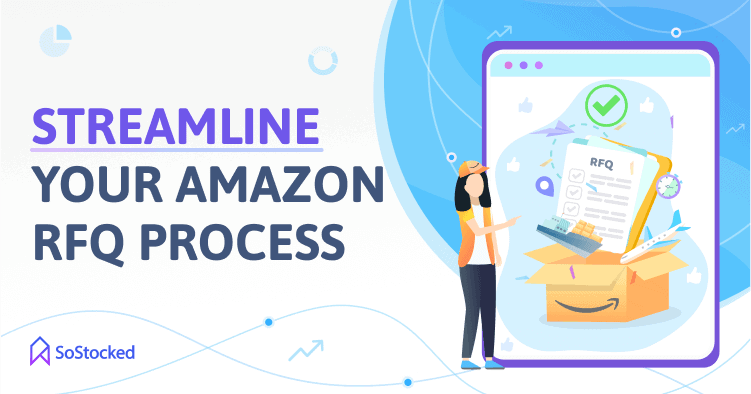
Preparing for Amazon shipment doesn’t have to be a long and arduous task. A Request for Quote (RFQ) document is an effective way to receive and compare quotes from various carriers when looking for reasonable rates.
Using a standard template also makes it easier to specify what you need and put all shipping information together, such as product details, origin and destination addresses, mode of transport, cargo date ready, and packaging details, to ensure you don’t leave out any details crucial to the proper execution of your quote.
Additionally, take shipping stages and estimated transit times into consideration while preparing your RFQs and shipments. Doing this extra step will help ensure you get your inventory shipped out in time to avoid stocking out.
Finally, streamline your inventory tracking process with SoStocked. Create POs and Work Orders, assign lead times, and monitor the Order Tracker dashboard to keep an eye on your incoming shipments.
Need more information?
- Send Message: We typically reply within 2 hours during office hours.
- Schedule Demo: Dive deeper into the nuances of our software with Chelsea.
- Join Live Upcoming Webinar: New to Amazon inventory management? Learn three inventory techniques you can implement right away.
 Get Started
Get Started
A great article with an almost overwhelming amount of information, perfectly organized and very actionable.
This doesn’t compare to what you can see on other business websites where you get only a few pieces of information, just enough so you can understand that it’s only the peak of the iceberg and that you further need their services to get the whole picture. 🙂
You’re doing a wonderful job, Chelsea and Ari!!!!
Thanks so much for saying so. We work hard to find all of the most relevant data. There is no point in data that is not actionable so we always approach everything we do with that focus in mind.